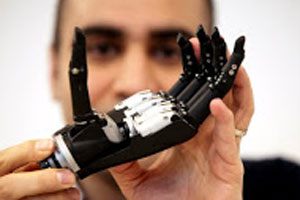02 March 2015
Bionic hand that communicates with the nervous system
Colchester Campus

Dr Kianoush Nazarpour with the bionic hand
A bionic hand that can sense pressure and temperature and transmit the information back to the brain is the focus of a new £1.4m UK research project, involving the University of Essex.
Led by Newcastle University and involving experts from the universities of Essex, Leeds, Keele, Southampton and Imperial College London, the aim is to develop novel electronic devices that connect to the forearm neural networks to allow two-way communications with the brain.
Reminiscent of Luke Skywalker’s artificial hand, the electrodes in the bionic limb would be inserted into the nerves in the arm. This would mean the hand could communicate with the brain via the nerve fibres, sending back real-time information about temperature, pressure and force on the prosthetic hand.
The three-year project is being funded by the Engineering and Physical Sciences Research Council (EPSRC). Led by Dr Kianoush Nazarpour, a lecturer in Biomedical Engineering at Newcastle University, the team hope to develop a number of enabling technologies to give amputees a real sense of feedback and create a limb with novel sensors that more closely mirrors the real thing.
“The UK leads the way in the design of prosthetic limbs but until now one of the limiting factors has been the technology to allow the hand to communicate with the brain,” explained Dr Nazarpour.
Leading the team at Essex is neuro-engineering expert Dr Francisco Sepulveda, who will undertake part of the project involving gaining a better understanding of the interaction between electronic implants and the nervous system and to create a computational model of this interaction. This will then help to dictate the design of future implants.
“Our aim at Essex is to have the methodology in place so there will be bespoke nerve implants in the future which will minimize the huge waste of resources currently used in a ‘trial and error’ approach,” he explained. “For the patients the hope is that in the future this technology will restore their sensation in a manner that is as close to natural as possible.”
By advancing the field of prosthetics, this project will provide enhanced function to prosthesis users, and also reduce the time involved to learn how to use the device because the movements will come naturally.
Bringing together some of the UK’s leading researchers in this field of rehabilitation research, the team will also use advanced 3D manufacturing techniques to build fingertip sensors to give the prosthesis a realistic sense of touch, including pressure, force and temperature.
Building this level of feedback into prosthetic devices will enable much higher levels of function for people who have lost their limbs than is currently available.
Ends
Note to editors
For more information please contact the University of Essex Communications Office on 01206 872400 or email comms@essex.ac.uk
...more news releases